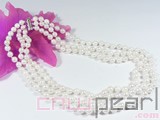Even though bigger may seem
Wednesday, July 9th, 2008
Even though bigger may seem better when it comes to diamonds and rare gems, this isn’t always the case. In fact, as important as carat weight may be, it is not the only important determining factor when evaluating a stone’s value. Jewelers also look at a gemstone’s clarity, cut and color. In this article however, we’ll focus exclusively on the carat and how it affects a gem stone’s value.
First, it’s important to remember that a carat is a measurement of weight, not size. A larger stone may be less dense and therefore have a lower carat weight than a smaller stone. Also, different stones have different carat weights, so a one-carat ruby will not be the same size as a one-carat sapphire.
Typically, diamonds are cut to similar proportions, meaning generic diamonds of a particular carat weight tend to be more or less the same size. For example, if someone wants a one-carat, round diamond, they’ll usually get a diamond that’s about 6.5 millimeters across the top, and if they want a two-carat, round diamond, it will be about 8.2 millimeters across.
But, what if the proportions are different? In addition to a stone’s density, how it’s cut (that is, its proportions) can also affect its size relative to carat weight. For example, if a cutter wants a very heavy carat weight, he will cut a stone deep to get the bulk of the weight in the bottom portion. This means the stone can look small, but still feel heav
Other examples include a stone that is cut with a shallow cut, usually done to bring out a lighter tone, which can make the gem appear larger despite its low carat weight.
Today, a carat is equal to approximately one-fifth of a gram and divisible by a hundred points. Typically, the higher the carat weight, the higher the price. In addition, certain carat weight levels carry particular price points. The difference in price between a 1.0 carat diamond and a .99 carat diamond is much greater than that between a .99 carat diamond and a .98 carat diamond.
For most everyday jewelry and stone buyers, asking for a specific size is going to be more effective than requesting a specific carat weight. Because of the discrepancies in sizes and proportions when it comes to carat measurements, you’re more likely to get the stone and style you want if you focus on the aesthetics of size and diameter instead.
Citrine, a form of quartz similar to amethyst, was one of the most prized gemstones in antiquity because of its rare occurrence in nature. When intense heat is applied to the gemstone amethyst, it is transformed into citrine. This can happen in nature when deposits of amethyst are near a heat source in the earth’s crust, but more often heat is applied industrially to create citrine. It can be transparent to translucent, and range in color from light yellow to golden brown. Naturally occurring citrine is usually a pale yellow, while citrine formed industrially is darker in color, with reddish tints.
In wholesale pearls jewelry store you can not only get the most fashionable style of pearl necklace, single pearl necklace, twisted pearl necklace, multi-strand pearl necklace but also get the most favourable price, very valuable to choose any style of pearl earrings, pearl pendant, pearl ring, pearl bracelet and pearl sets.

